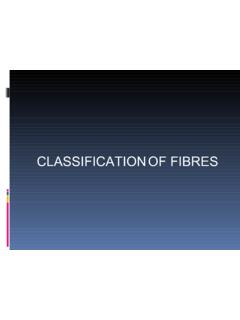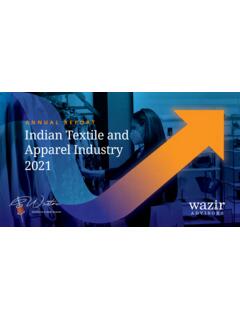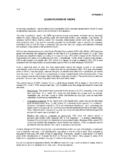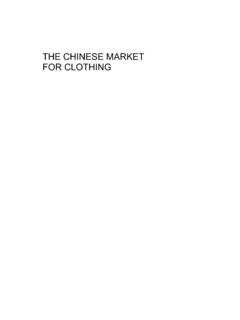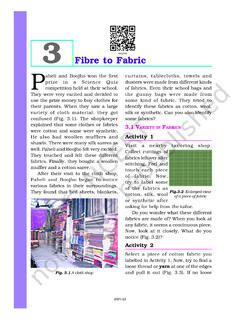Transcription of MANUAL FOR THE IMPLEMENTATION OF GOTS
1 MANUAL FOR THE IMPLEMENTATION OF GOTS BASED ON THE GLOBAL ORGANIC TEXTILE STANDARD (GOTS) VERSION Global Standard gemeinn tzige GmbH Roteb hlstr. 102 70178 Stuttgart Germany GOTS IMPLEMENTATION MANUAL Version March 2020 Page 2/39 TABLE OF CONTENTS TABLE OF CONTENTS _____ 2 INTRODUCTION _____ 4 OFFICIAL INTERPRETATIONS FOR SPECIFIC CRITERIA OF GOTS, VERSION _____ 5 1 PRINCIPLES _____ 5 SCOPE AND STRUCTURE _____ 5 CERTIFICATE OF COMPLIANCE _____ 6 2 CRITERIA _____ 6 REQUIREMENTS FOR ORGANIC FIBRE PRODUCTION _____ 6 Products sold, labelled or represented as "organic" or "organic-in conversion _____ 7 Products sold, labelled or represented as "made with x % organic materials" or "made with x % organic-in conversion materials"_____ 7 Prohibited and restricted inputs _____ 8 Requirements related to hazards and toxicity _____ 14 Assessment of chemical inputs _____ 15 Product Stewardship of chemical inputs _____ 16 Environment.
2 Health and Safety for Chemical Suppliers _____ 16 Spinning _____ 17 Dyeing_____ 17 Dyeing and Printing _____ 18 Requirements for additional fibre materials _____ 18 Requirements for Accessories _____ 19 Environmental management _____ 20 Wastewater Treatment _____ 21 Storage, packaging and transport _____ 23 B2B trade of GOTS goods _____ 23 Retail (B2C) trade of GOTS goods _____ 23 Record keeping & internal quality assurance _____ 24 Technical quality parameters _____ 25 Limit values for residues in GOTS Goods _____ 25 Limit values for residues in additional fibre materials and accessories _____ 25 3 SOCIAL CRITERIA _____ 28 SCOPE _____ 28 REMUNERATION AND ASSESSMENT OF LIVING WAGE GAP _____ 30 WORKING TIME _____ 30 SOCIAL COMPLIANCE MANAGEMENT _____ 31 4 QUALITY ASSURANCE SYSTEM _____ 31 AUDITING OF PROCESSING, MANUFACTURING AND TRADING STAGES _____ 31 GOTS IMPLEMENTATION MANUAL Version March 2020 Page 3/39 TESTING OF TECHNICAL QUALITY PARAMETERS AND RESIDUES _____ 35 5 ETHICAL BUSINESS BEHAVIOUR _____ 37 6 ANNEX _____ 38 Specific requirements for textile personal care products _____ 38 Specific criteria for Inputs _____ 38 SPECIFIC REQUIREMENTS FOR FOOD CONTACT TEXTILES _____ 38 GOTS IMPLEMENTATION MANUAL Version March 2020 Page 4/39 INTRODUCTION This document provides interpretations and clarifications for specific criteria of the Global Organic Textile Standard (GOTS) and related official reference documents ( the Licensing and Labelling Guide) approved by the Standards Committee (SC) of the Global Standard gGmbH where the current wording of the specific criteria could lead to (or already led to)
3 Inconsistent, inappropriate or even incorrect interpretation. It may further contain requirements for the application of the GOTS and the IMPLEMENTATION of the related quality assurance system for certifiers. This MANUAL is to be seen as a flexible quality assurance tool of the SC to give advice and clarification to the GOTS Approved Certifiers and users of the GOTS where felt necessary as it can be up-dated short-term, however it does not deal with revision questions of the current standard version or even set any revised criteria. The interpretations, corrections and further clarifications as provided with this document are binding for all GOTS Approved Certifiers and users of the GOTS. Any products already assessed and certified on basis of other interpretations which were also plausible with regard to the current wording of the GOTS retain their assessed / certified status.
4 The general IMPLEMENTATION deadline to comply with a new version of the standard, this MANUAL or another official reference document published by the Global Standard gGmbH is 12 months after its release unless other / specific advice is given. Note: In this MANUAL , the relevant Section of GOTS is quoted to which the interpretations and further clarifications refer to. Partial wording is symbolized by .. In all cases, the wording from the Standard are to be considered definitive in this regard. * * * * * * * GOTS IMPLEMENTATION MANUAL Version March 2020 Page 5/39 OFFICIAL INTERPRETATIONS FOR SPECIFIC CRITERIA OF GOTS, VERSION 1 PRINCIPLES SCOPE AND STRUCTURE .. "The final products may include, but are not limited to fibre products, yarns, fabrics, garments, fashion textile accessories (carried or worn), textile toys, home textiles, mattresses and bedding products as well as textile personal care products.
5 " .. Interpretation: In principle, any product that can be considered as a textile fibre product is covered under the scope of this standard. Textile fibre products containing electronic components are excluded. This standard does not cover products made from non-fibre materials such as leather, skin or hide. A textile fibre product can only be certified and labelled ('organic' or 'made with organic') as a whole. It is not possible to certify and label only a part or component of such a product. Combined Product: Textile fibre components of a consumer product which is not normally classified as a textile fibre product (such as prams with textile fabrics, bassinets, car seats or furniture with textile fabric upholstery) may also be certified and labelled appropriately ensuring no ambiguity about which component of the entire product is certified. For example: Combined product: (name of component) certified to GOTS.
6 Products / components that do not carry specific mention or requirements elsewhere within the GOTS Standard may be considered as Combined Products. It is the certifier s responsibility to examine the remaining components regarding their overall compatibility to GOTS philosophy and to approve suitable labelling of such a product. Products that are certifiable to GOTS as a whole (like textile bags, ear buds, mattresses, etc.) cannot be considered for certification as a combined product..GOTS criteria or the local legal requirements, which is higher, shall be Interpretation: GOTS sets criteria that is stringent yet practical and is relevant in major textile markets. Local or national legal requirements vary across the world. If the local laws provide higher protection to environment or people, they shall be followed. Similarly, where local laws provide lower protection as compared to GOTS criteria, GOTS criteria would take precedence for the Certified Entities.
7 This is applicable to all aspects of the standard criteria, including environment, social, building safety, legality of business, and so on.. The Standard sets requirements on working and social conditions that are equivalent to those of leading social sustainability standards. Interpretation: Considering that the core function of this Standard is verifying and certifying processing of certified organic fibres, where a particularly high level of assurance of labour conditions is needed, applying a compatible specialised social standard or scheme is recommended. GOTS IMPLEMENTATION MANUAL Version March 2020 Page 6/39 CERTIFICATE OF COMPLIANCE Processors, manufacturers, traders and retailers that have demonstrated their ability to comply with the relevant GOTS criteria in the corresponding certification procedure to an Approved Certifier receive a GOTS Scope Certificate issued in accordance with the 'Policy and Template for issuing Scope Certificates (SCs)'.
8 Accordingly, they are considered Certified Entities. Scope Certificates list the products/product categories that the Certified Entities can offer in compliance with the Standard as well as the processing, manufacturing and trading activities that are qualified under the scope of certification. Subcontractors and their relevant processing and manufacturing steps become listed on the Scope Certificate of the Certified Entity assigning the certification. Interpretation: Detailed mandatory instructions with regard to policies, layout, format and text for issuing Certificates of Compliance are provided for in the 'Policy and Template for issuing Scope Certificates (SCs)' as available on the GOTS website The applicable Approved Certifiers enter all Certified Entities, the products/product categories that they can offer in compliance with the standard as well as the processing steps/activities that are qualified under the scope of certification into the GOTS public data base.
9 Refer : 2 CRITERIA REQUIREMENTS FOR ORGANIC FIBRE PRODUCTION " Approved are natural fibres that are certified 'organic' or 'organic - in conversion' according to any standard approved in the IFOAM Family of Standards for the relevant scope of production (crop or animal production), such as Regulation (EC) 834/2007, USDA National Organic Program (NOP), APEDA National Programme for Organic Production (NPOP), China Organic Standard GB/ T19630. The certification body shall have a valid and recognised accreditation for the standard it certifies against. Recognised accreditations are ISO 17065 accreditation, NOP accreditation, IFOAM accreditation. References: USDA NOP (USA Organic Regulation) List of NOP accredited certifiers APEDA NPOP EU 2018/848 (EU Organic Regulation) EC 889/2008 (providing IMPLEMENTATION rules for EC 834/2007 regarding organic production, labelling and control) EC 1235/2008 (providing IMPLEMENTATION rules for EC 834/2007 regarding imports of organic products from third countries) List of standards approved in the IFOAM Family of Standards List of IFOAM accredited certifiers GOTS IMPLEMENTATION MANUAL Version March 2020 Page 7/39 Further clarifications: Organic fibre certification according to JAS is not possible.
10 (-> per definition of JAS) Certification of 'in conversion' (resp. 'in transition') status is not possible according to USDA NOP. (-> per definition of NOP) The USDA policy memorandum "Labeling of Textiles That Contain Organic Ingredients" clarifies that textile products that are produced in accordance with GOTS may be sold as organic in the A valid requirement in this context is that all of the fibres identified as organic in these textiles shall be produced and certified to the USDA NOP regulations. Legal requirements ( with regard to organic fibre certification) may also apply in other countries and shall be respected. Reference: USDA policy memorandum "Labelling of Textiles That Contain Organic Ingredients" Guidance: ISO 20921:2019 - (Textiles - Determination of stable nitrogen isotope ratio), Annex A (identification procedure of organic raw cotton fibre by using stable nitrogen isotope ratio) may be used as an indicator to determine if cotton fibres have been cultivated using compost fertilisers.


